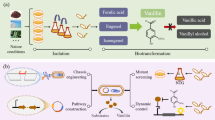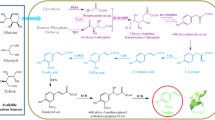Abstract.
Vanillin is one of the most important aromatic flavor compounds used in foods, beverages, perfumes, and pharmaceuticals and is produced on a scale of more than 10 thousand tons per year by the industry through chemical synthesis. Alternative biotechnology-based approaches for the production are based on bioconversion of lignin, phenolic stilbenes, isoeugenol, eugenol, ferulic acid, or aromatic amino acids, and on de novo biosynthesis, applying fungi, bacteria, plant cells, or genetically engineered microorganisms. Here, the different biosynthesis routes involved in biotechnological vanillin production are discussed.
Similar content being viewed by others
Author information
Authors and Affiliations
Additional information
Received revision: 6 April 2001
Electronic Publication
Rights and permissions
About this article
Cite this article
Priefert, .H., Rabenhorst, .J. & Steinbüchel, .A. Biotechnological production of vanillin. Appl Microbiol Biotechnol 56, 296–314 (2001). https://doi.org/10.1007/s002530100687
Received:
Accepted:
Issue Date:
DOI: https://doi.org/10.1007/s002530100687




